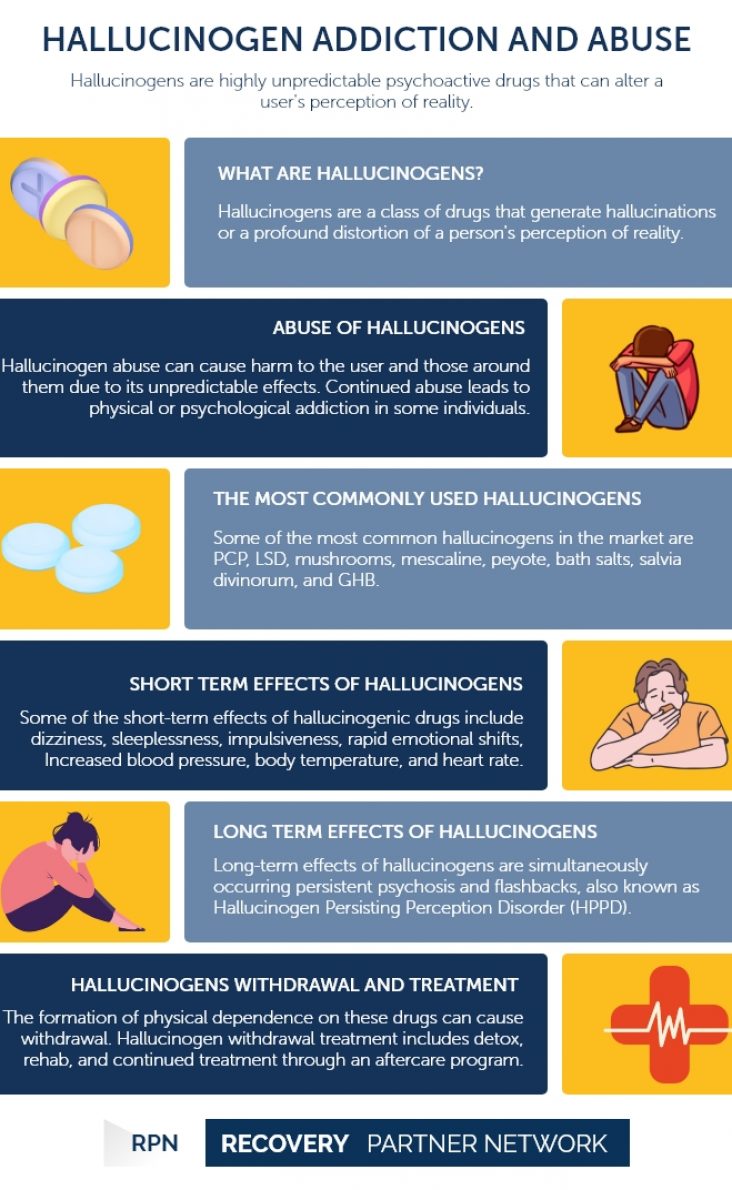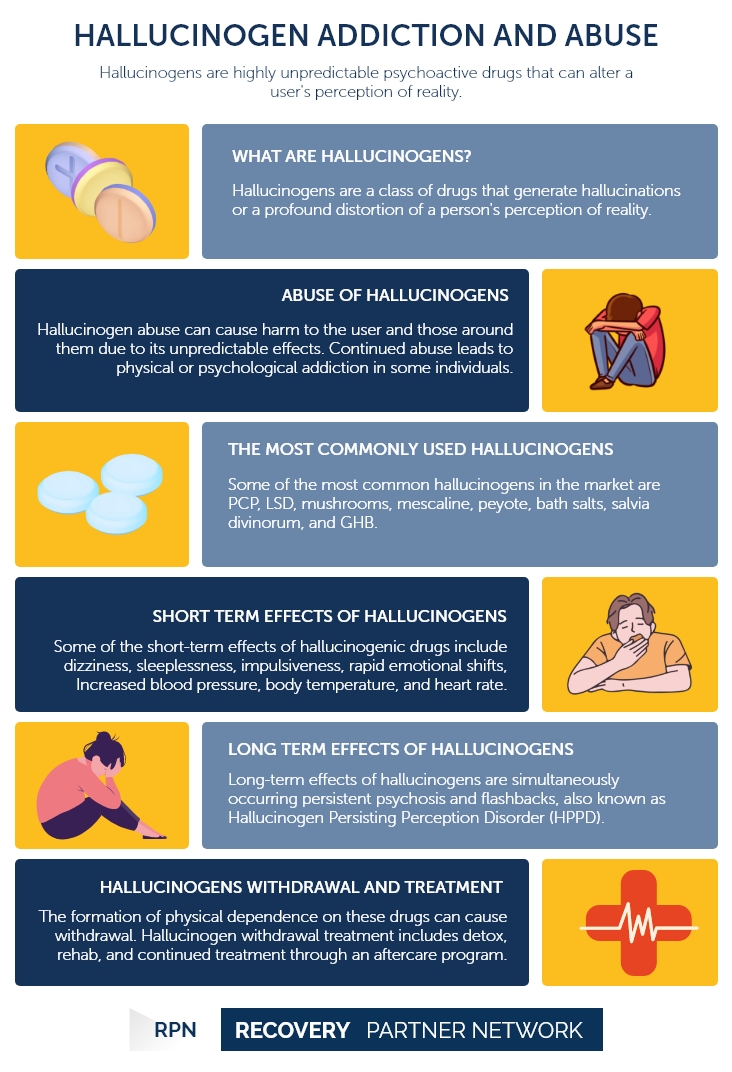Hallucinogens are highly unpredictable psychoactive drugs that can alter a user’s perception of reality.
Hallucinogen Addiction and Abuse
Illicit drugs
- Ayahuasca addiction – Abuse
- Baclofen addiction
- Black tar heroin addiction
- Cannabis addiction
- Cocaine dependence
- Crack cocaine addiction
- DMT addiction abuse treatment
- Does Marijuana Kill Brain Cells?
- Ecstasy addiction
- Gabapentin addiction
- gamma-Hydroxybutyric acid addiction
- Hallucinogen
- Heroin addiction
- Illicit drug addiction
- Inhalant addiction
- Cocaine
- Ketamine addiction
- Lysergic acid diethylamide addiction
- Mescaline addiction
- Methamphetamine addiction
- Meth Labs: Cooking up Addiction
- Meth Mouth
- Microdosing
- Phencyclidine addiction
- Psilocybin mushroom addiction
- Sage of the diviners – Addiction
- Shooting Heroin
- Shooting Methamphetamine
- Smoking Cannabis
- Speedball
- Synthetic cannabinoids
Hallucinogen | Table of Contents
What are Hallucinogens?
Hallucinogens are a class of drugs that generate hallucinations or a profound distortion of a person’s perception of reality. Hallucinogens are either found naturally in plants and mushrooms or are man-made. They are typically categorized into two broad categories, such as classic hallucinogens (such as LSD) and dissociative drugs (such as PCP). When under the influence of either of these hallucinogens, individuals may experience strong emotional mood swings along with seeing, hearing, or feeling sensations that are not real.
FAQ
- What does hallucinogens do to your body?
- What are examples of hallucinogens?
- What is the history of hallucinogens?
Hallucinogens are a class of drugs that induces hallucinations that alter perception, thoughts, and feelings.
Examples of hallucinogens are DMT, Psilocybin (magic mushrooms), Lysergic Acid Diethylamide (LSD), Phencyclidine (PCP), mescaline (peyote cactus), ketamine, morning glory seeds, and datura.
The very first synthetic hallucinogen, diethylamide lysergic acid (LSD), was discovered by Sandoz laboratories in 1938 while researching for a new ergot-derived analeptic agent.
Abuse of Hallucinogens
Since most psychoactive substances are considered illegal or heavily regulated, any amount of use should be a cause for concern. Hallucinogen abuse can cause serious harm to the user and to those around them due to its unpredictable effects. Continued abuse can give rise to physical or psychological addiction in some individuals.
Hallucinogens Drug Dependence and Addiction
Although addiction to psychoactive drugs is less common than most other substances, many still find themselves dependant, on its effects. Physical addiction is characterized by the formation of tolerance and dependence on the drug. During this formation, individuals will require higher doses than before to achieve the desired effects as well as experience withdrawal symptoms during discontinuation of their drug use. An addiction to a psychoactive drug can cause adverse mental health issues such as depression.
Psychological dependence occurs when the user:
- Feels strong urges to take the drug more frequently.
- Takes extreme measures to get hold of the substance.
- Starts avoiding responsibilities at home, work, and school.
- Avoiding friends and family in favor of using the drug.
- Continues the drug consumption despite being aware of the severe consequences of doing so.
FAQ
- What age group uses hallucinogens the most?
- What is the most powerful hallucinogen?
- What are the side effects of hallucinogens on patients with mental health disorders?
According to the NHSDA (National Household Survey on Drug Abuse), it was found that in the year of 1995, the use of hallucinogens was most common at the age of 19. The survey also noted that the transition from adolescence to adulthood is the period in which most individuals used hallucinogens.
LSD, also known as acid, is among the most powerful hallucinogenic drugs available.
The use of hallucinogens in people vulnerable to mental health problems can trigger anxiousness, depressive symptoms, psychosis, paranoia, flashbacks and panic attacks.
The Most Commonly Used Hallucinogens
Phencyclidine (PCP) is a dissociative anesthetic that was stopped for human consumption in the year 1965. This drug is known to produce an “out of body” feeling, and coming down from its anesthetic effects can cause users to have feelings of agitation and irrationality.
PCP is added to many other street drugs (including LSD, marijuana, and methamphetamine). The addition of PCP to these drugs amplifies their psychedelic effects. Mainly distributed as a powder, PCP is snorted, smoked, and swallowed.
PCP can cause hallucinations, comas, and seizures when abused at high dosages. PCP induced deaths are most common when the user commits suicide or gets involved in an accident due to his /her altered state of consciousness.
PCP is also known by the below-mentioned names :
- Angel dust
- Embalming fluid
- Killer weed
- Zoom
- Supergrass
- Peace pills
Lysergic Acid diethylamide, also known as LSD, is a highly effective synthetic hallucinogen. LSD was initially used in psychiatric therapy and research. However, its contribution and value as a therapeutic substance were largely debunked in the 1980s.
Today LSD is considered as a Schedule 1 drug. This drug is generally abused by users in their late teens or early twenties. LSD is considered by these users as a club drug along the same lines as MDMA and Ketamine.
LSD impacts the neurotransmitter serotonin. This neurotransmitter plays a part in regulating the control of behavioral, regulatory, and perceptual systems. By interfering with these systems, LSD generates hallucinogenic effects where the user loses his /her grasp on reality and has visions and a confusing blend of senses.
Magic mushrooms are a type of fungus that naturally produces psychedelic substances, such as psilocybin and psilocin. These hallucinogenic substances are chemically akin to LSD. Psilocybin is regarded as a Schedule I Substance under the Controlled Substances Act, as it holds no legitimate medical function and a high potential for abuse.
Psychedelic mushrooms generate several effects, such as:
- Heightened sensory
- Impaired judgment
- Inability to distinguish between fantasy and reality
- Frightening hallucinations
- Depression
- Panic attacks
- Terror
Mescaline is a naturally formed psychedelic drug that is found in the peyote cactus. Peyote has been used for generations in Native American culture, and it is the oldest known psychedelic agent. It was such a central part of Native American culture that the Native American Church was established in 1918 to solely preserve their rights to use the drug.
Mescaline has been regarded as an effective drug in treating depression and alcoholism. However, its negative effects far outweigh the positives, and thus, it was classed as a Schedule I Substance. The psychological effects of mescaline consumption may vary depending on the users’ body type, personality, history of drug use, and the user’s expectation of the drug use.
Some of the common effects of mescaline/peyote use are:
- Distorted sense of body
- Vivid mental images
- Altered space
- Altered perception of time
- Losing a sense of reality
Bath salts are a concoction of synthetic stimulants, with no particular chemical makeup. Each batch of bath salt may differ slightly from one another, with the main ingredient often being a synthetic version of cathinone (a substance discovered in khat). Most drug labs tend to slightly modify their bath salts‘ chemical structure to bypass federal regulations. This further contributes to the drugs‘ inconsistency and volatility.
Bath salts have been the main cause of many disturbing and bizarre incidents since 2012. The most publicized of these bizarre incidents was that of a 31-year-old Miami man who attacked a homeless man by clawing his clothes off and attempting to chew off his face. Many bath-salts users claim to have witnessed seeing demons and monsters while being hospitalized.
Salvia divinorum is a psychoactive plant that triggers hallucinations and visions when consumed. Also known as Sage of the Seers or the Diviner’s Sage, this drug can generate a sensation of traveling through time and flying/floating above the ground. Dizziness, nausea, chills, and lack of co–ordination are a few of the physical effects of this substance. Salvia divinorum is currently a legal drug in the US.
Gamma – hydroxybutyric acid (GHB) is a naturally occurring neurotransmitter and a psychoactive drug that is synthesized for its sedative and intoxicating effects. GHB is a central nervous system depressant that can cause a variety of side effects depending on the amount consumed and the presence of other drugs in the user‘s system.
Some of the commonly reported side effects of GHB are:
- Euphoria
- Decreased inhibitions
- Sleepiness
- Disorientation
- Loss of co–ordination
- Decreased heart rate
Short Term Effects of Hallucinogens
The effects of hallucinogens typically begin within 20 to 90 minutes after consumption and generally last for 12 hours. The effects are highly unpredictable and sometimes dangerous.
Some of the short-term effects of hallucinogenic drugs, as provided by the National Institute on Drug Abuse (NIDA), are:
- Dizziness
- Sleeplessness
- Impulsiveness
- Rapid emotional shifts
- Increased blood pressure, body temperature, and heart rate
- Dry mouth
- Sweating
- Numbness
- Tremors
- Weakness
- Loss of appetite
Long Term Effects of Hallucinogens
Two of the more severe long-term effects of hallucinogens are persistent psychosis and flashbacks, also known as Hallucinogen Persisting Perception Disorder (HPPD). Most times, these two conditions occur simultaneously.
Symptoms of persistent psychosis may include:
- Disorganized thinking
- Mood disturbances
- Visual disturbances
- Paranoia
FAQ
- How do hallucinogens work on the brain?
- Are hallucinogens harmful?
- Do hallucinogens increase heart rate?
Hallucinogens function by activating or suppressing the functioning of the chemically alike neurotransmitters. This causes the brain to experience a temporary chemical imbalance, which causes hallucinations and other symptoms, including euphoria.
There are many risks associated with taking hallucinogens as they can cause you to experience anxiety, fear, and paranoia, sometimes verging on psychosis. It can also cause serious harm or accidents to you and those around you while you are under its influence.
Most hallucinogens tend to increase the heart rate.
Hallucinogen Persisting Perception Disorder (HPPD)
Individuals who consume hallucinogens may sometimes re-experience the drug’s effects days, weeks, or even years later. These experiences are referred to as flashbacks. The frequent occurrence of such flashbacks is known as hallucinogen persisting perception disorder. HPPD is a chronic disorder that can be debilitating and unsettling for many.
Symptoms of HPPD may include:
- Intensified colors, flashes of color, or color confusion
- Halos around objects
- Seeing geometric patterns
- Seeing images within images
- Feeling uneasy
- Difficulty in reading
Hallucinogens Withdrawal and Treatment
Not all hallucinogens generate withdrawal symptoms, as most lack the potential to cause physical dependence. However, some drugs, such as PCP and ketamine, do stand out from the rest. The formation of physical dependence on these drugs can cause withdrawal symptoms when an individual tries to stop consuming them.
Some of the withdrawal symptoms of hallucinogens are:
- Stiff muscles
- Depressed breathing
- Convulsions
- Rapid heart rate
- Extreme changes in body temperature
- Cravings
- Headaches
- Sweating
- Seizures
- Flashbacks
Quitting hallucinogen use can be difficult, particularly if one experiences severe withdrawal symptoms. Due to the severity of withdrawal, patients are highly advised to seek medical assistance during detoxification. Medical detox helps alleviate the intensity of withdrawal symptoms, hence decreasing the chances of a relapse. Medical detox also provides a safe and supportive environment that contributes to lasting sobriety, physical healing, and emotional healing. After the completion of detox, further treatment will be provided at an inpatient or outpatient rehabilitation center.
Inpatient or outpatient rehabs provide many different types of specialized and behavioral therapies to address the root cause of a patient’s addiction. These therapies are vital in helping uncover co-occurring mental health disorders that may have contributed to substance abuse.
After the successful completion of inpatient or outpatient treatment programs, patients are highly advised to continue with treatment through an aftercare program to help them navigate in their journey to recovery.
Recovery Partner Network
We aim to educate and empower. If you feel our library of resources does not cover your specific need, reach out to us, and we would be happy to help.
STATISTICS
© Copyright 2025


